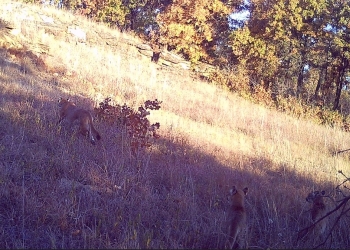News
Wildlife
Posted: Jun 10, 2025 10:52 AMUpdated: Jun 10, 2025 10:52 AM
Mountain Lion Kittens Confirmed in Osage County

Mountain lion kittens have been confirmed in Osage County.
The Oklahoma Department of Wildlife Conservation says an adult mountain lion with two half-grown kittens were photographed by a trail camera in October on private property in Osage County. An adult mountain lion and three smaller kittens were also confirmed in Cimarron County in the Oklahoma panhandle.
“While exciting and interesting, these sightings are just one small piece of the puzzle needed to better understand this species,” said Jerrod Davis, furbearer biologist for the Wildlife Department. “It's our first piece of evidence that mountain lions may be breeding in Oklahoma, a key indicator the population is becoming established. That two female mountain lions have established at least part of their territories in Oklahoma is a direct reflection of a healthy ecosystem.
“It could open the door for potential research. Our first focus should be evaluating the abundance and distribution of mountain lions in the state. We’ve been confirming sightings through our online reporting process for more than 20 years and may deploy more intensive camera arrays. Depending on those surveys, further research may be possible.”
These family groups represent the first ODWC-confirmed instances of possible reproduction of mountain lions within the state, but the Wildlife Department has confirmed 85 sightings of individuals since 2002, with an uptick in confirmed sightings in 2023. It is important to note that some of these sightings could actually be of the same individual. This upward trend also has been observed by states in the Midwest Association of Fish and Wildlife Agencies. Before the photographic evidence of kittens in Oklahoma, biologists concluded the numerous tracks, photos, and road-killed animals of different ages and both sexes documented in the state were of transient individuals. The closest established populations are in Texas, New Mexico, Colorado, and Nebraska.
Established territories fluctuate with habitat conditions. Female mountain lions are thought to have a home range of up to 75 square miles, while that of males may be up to 275 square miles. Home ranges of females or of males and females may occasionally overlap but home ranges of males rarely overlap.
Adult mountain lions are light brown in color with a pale or white belly and black tail tip. The backs of the ears are usually black. The tail is more than half the length of the head and body. Males weigh 120 to 160 pounds on average while females average 75 to 110 pounds. From nose to tail, males may measure 8 feet in length and stand 30 inches at the shoulder. Juveniles have shorter tails and spotted coats that fade with age.
Mountain lions are able to reproduce at two years of age, and most females reproduce in alternate years with an average litter size of three. Kittens can be born in any month, but the birth period is often timed to correspond with that of ungulates, the base prey group. Kittens are weaned after two to three months but may remain with the female for two years.
Though mountain lions are opportunistic hunters that feed on a variety of large and small mammals, deer are a dietary staple. One Texas study reported white-tailed and mule deer made up 82% of the species’ diet. Other studies show mountain lions kill an average of 48 ungulates annually, per individual, across their North American range.
In Oklahoma, mountain lions have been classified as a game species with a closed hunting season since 1957. But a 2007 law allows for the killing of mountain lions depredating livestock or when people are threatened. To date, only one mountain lion has been killed under this provision. In the event a mountain lion is taken, a Wildlife Department employee must be notified immediately and the intact carcass, including the hide, must be presented within 24 hours for collection of biological information. The U.S. Department of Agriculture’s Wildlife Services also may be able to assist with wildlife damage concerns.
« Back to News















